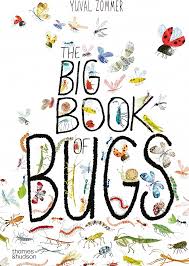|
The Big Book of Bugs is the first book in Yuval Zommer’s
‘The Big Book of’ series and it is jam-packed with
fascinating facts, questions and answers.
Bugs are brilliant. They fly, they creep, they slide, they crawl, they wriggle, they buzz, they scuttle and some even bite and sting, and this book is full of them. There are caterpillars that change into butterflies, beetles that carry a suit of armour, moths with fake eyes, bees that make honey, flies that walk upside down, centipedes as big as a dinner plate, stick insects that can regrow limbs, bugs that can walk on water and a whole lot more. Ever wondered…Why do ants march in a line? Why termites build ‘castles’? Why is there always a pesky fly around when you’re trying to eat you food? How many legs does a centipede actually have? Could a dragonfly burn you with its fire-breathing? Well, The Big Book of Bugs has the answers to all of these questions and more. Throughout the book, Zommer introduces readers to a whole host of bugs and also provides lovely informative pages on how to be an excellent bug spotter, the helpful things that bugs do and how to make bugs feel more welcome and at home in your garden. As well as a plethora of fantastic information there are lots of fun ‘can you find’ activities to keep readers busy and engaged. From finding stick insects hiding on branches to poo-rolling dung beetles to spotting the wasps amongst the bees. And there are many other insects that are flying, crawling and sliding across the pages that need finding and counting. There is also a more generic challenge in which readers are given the task of finding the sneaky fly who has found his way into fifteen of the spreads.
The Big Book of Bugs
is produced across twenty eight double page spreads.
Each double page spread focuses on a specific topic
or bug and is laid out in an inviting way for the
reader. The pages are colourful and are packed full
of stunning illustrations that are detailed and
vibrant.
This feels like a proper grown-up non-fiction book and young readers will no doubt love that there is a contents, an index and a glossary that comes in the form of ‘Bug Words’ so young bug spotters can speak like an expert. The book is a fabulous way for children to learn about the incredible insects and brilliant bugs that are living in our gardens and in some cases inhabiting our homes. It is a brilliant book for any budding entomologist and will be devoured by children who want to find out about all manner of creepy crawlies and winged wonders. The book is published as a large format coffee-table sized book with thick pages that will hold up to endless hours of exploration. Recommended for 5+. |
Practice mechanics inside yohoho slots freeplay. Test features before switching to real stakes.

